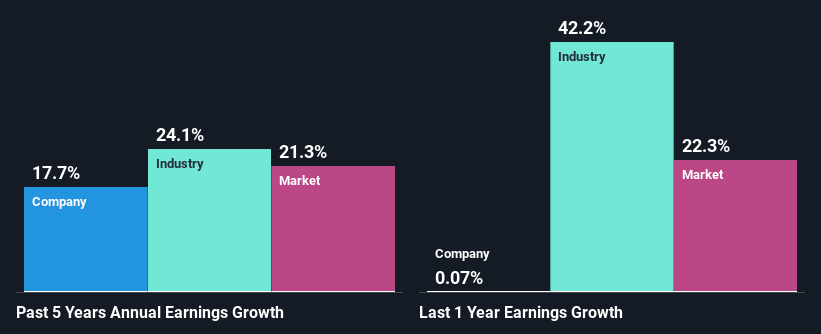Stock Analysis
- India
- /
- Electrical
- /
- NSEI:MARINE
Is Marine Electricals (India) Limited's (NSE:MARINE) Recent Stock Performance Influenced By Its Fundamentals In Any Way?

Marine Electricals (India) (NSE:MARINE) has had a great run on the share market with its stock up by a significant 24% over the last month. We wonder if and what role the company's financials play in that price change as a company's long-term fundamentals usually dictate market outcomes. Specifically, we decided to study Marine Electricals (India)'s ROE in this article.
Return on equity or ROE is a key measure used to assess how efficiently a company's management is utilizing the company's capital. Put another way, it reveals the company's success at turning shareholder investments into profits.
See our latest analysis for Marine Electricals (India)
How To Calculate Return On Equity?
ROE can be calculated by using the formula:
Return on Equity = Net Profit (from continuing operations) ÷ Shareholders' Equity
So, based on the above formula, the ROE for Marine Electricals (India) is:
7.7% = ₹175m ÷ ₹2.3b (Based on the trailing twelve months to December 2023).
The 'return' is the income the business earned over the last year. So, this means that for every ₹1 of its shareholder's investments, the company generates a profit of ₹0.08.
Why Is ROE Important For Earnings Growth?
Thus far, we have learned that ROE measures how efficiently a company is generating its profits. We now need to evaluate how much profit the company reinvests or "retains" for future growth which then gives us an idea about the growth potential of the company. Assuming everything else remains unchanged, the higher the ROE and profit retention, the higher the growth rate of a company compared to companies that don't necessarily bear these characteristics.
Marine Electricals (India)'s Earnings Growth And 7.7% ROE
As you can see, Marine Electricals (India)'s ROE looks pretty weak. Even when compared to the industry average of 15%, the ROE figure is pretty disappointing. Although, we can see that Marine Electricals (India) saw a modest net income growth of 18% over the past five years. Therefore, the growth in earnings could probably have been caused by other variables. For example, it is possible that the company's management has made some good strategic decisions, or that the company has a low payout ratio.
We then compared Marine Electricals (India)'s net income growth with the industry and found that the company's growth figure is lower than the average industry growth rate of 24% in the same 5-year period, which is a bit concerning.

Earnings growth is a huge factor in stock valuation. It’s important for an investor to know whether the market has priced in the company's expected earnings growth (or decline). Doing so will help them establish if the stock's future looks promising or ominous. If you're wondering about Marine Electricals (India)'s's valuation, check out this gauge of its price-to-earnings ratio, as compared to its industry.
Is Marine Electricals (India) Efficiently Re-investing Its Profits?
While the company did pay out a portion of its dividend in the past, it currently doesn't pay a regular dividend. We infer that the company has been reinvesting all of its profits to grow its business.
Conclusion
On the whole, we do feel that Marine Electricals (India) has some positive attributes. Specifically, its fairly high earnings growth number, which no doubt was backed by the company's high earnings retention. Still, the low ROE means that all that reinvestment is not reaping a lot of benefit to the investors. While we won't completely dismiss the company, what we would do, is try to ascertain how risky the business is to make a more informed decision around the company. Our risks dashboard will have the 1 risk we have identified for Marine Electricals (India).
Valuation is complex, but we're helping make it simple.
Find out whether Marine Electricals (India) is potentially over or undervalued by checking out our comprehensive analysis, which includes fair value estimates, risks and warnings, dividends, insider transactions and financial health.
View the Free AnalysisHave feedback on this article? Concerned about the content? Get in touch with us directly. Alternatively, email editorial-team (at) simplywallst.com.
This article by Simply Wall St is general in nature. We provide commentary based on historical data and analyst forecasts only using an unbiased methodology and our articles are not intended to be financial advice. It does not constitute a recommendation to buy or sell any stock, and does not take account of your objectives, or your financial situation. We aim to bring you long-term focused analysis driven by fundamental data. Note that our analysis may not factor in the latest price-sensitive company announcements or qualitative material. Simply Wall St has no position in any stocks mentioned.
About NSEI:MARINE
Marine Electricals (India)
Marine Electricals (India) Limited manufactures and sells various marine and industrial electrical and electronic components in India and internationally.
Excellent balance sheet with questionable track record.

